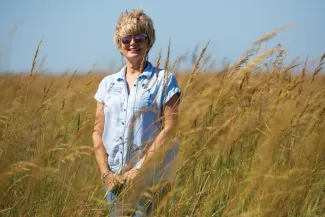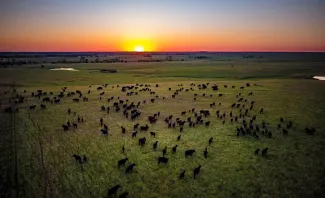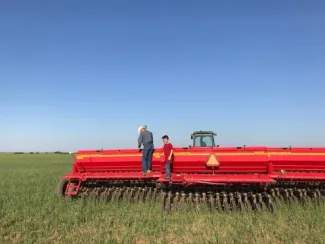The Oklahoma Department of Wildlife Conservation honors Oklahoma rancher Susan Bergen as its 2023 Landowner Conservationist of the Year. Bergen owns and manages cattle on 12,777 acres of tallgrass and mixed-grass prairie distributed over three tracts in portions of Cleveland, Johnston, Pontotoc, and McClain counties. The core of her ranching operation is an 11,500 acre property in the Arbuckle Plains that was purchased by her family in the late 1990s. Historically, this property was managed in a conventional way with continuous grazing and periodic herbicide application to control broadleaf forbs and shrubs. In 2012, Bergen embarked on a new approach to grazing and land management on her properties – one that uses restorative grazing to improve the structure and moisture retention of her ranch’s soil, enhance plant diversity, and eliminate the use of pesticides.

Susan Bergen focuses on building soil health and improving the land on her ranch.
Drawing on technical expertise from a variety of collaborators including the Noble Foundation, OSU Extension, and ODWC, she has developed and implemented a heavily monitored, rapid rotational grazing program. Her cattle are moved between grazing units every three to seven days and the cattle are shifted to a new unit as soon as the vegetation has been grazed to an average height of 8 to 10 inches. Each grazing unit is then rested for three to five months depending upon rainfall and plant growth. This frequent rotation provides for longer post-grazing recovery time for the prairie grasses and more closely mimics the historic grazing pattern of the mixed-grass and tallgrass regions. By maintaining taller vegetation, the grasses and forbs can sustain a greater root mass, which places more organic material in the soil to improve soil structure, retain moisture, and increase rainwater infiltration. Rather than conventional barbed wire fencing, Bergen uses a single strand of hotwire on easily moved posts to define the boundary of the grazing unit as the cattle are rotated.

Native grassland which has been carefully managed provides a food source for many cattle on the Bergen Ranch.
This rotational grazing system provides abundant cover for wildlife year-round and reduces competition between wildlife and cattle for forage and seeds. No herbicides have been applied on the ranch in 11 years and its forb diversity is continually increasing. The long rest periods between grazing events provide ample time for most forbs and grasses to flower and set seed each year, so although there are no food plots on the ranch, every grazing unit is producing seed and wildlife food. The ranch supports a complete community of grassland wildlife including northern bobwhite, black-tailed jackrabbits, and prairie-dependent birds such as dickcissel, grasshopper sparrow, and eastern meadowlark.
The ranch encompasses a portion of the headwaters of the Blue River on the east side and Pennington Creek on the west side. The protection of water quality in both of those biologically important watersheds is extremely important to Susan and she is proud of the fact that her ranch does not contribute pesticides, fertilizers, or sediment into either watershed. She is in the process of fencing off all of her ponds and streams to enhance riparian vegetation and further improve water quality. Rather than provide pond access to her cattle, she pumps water from her ponds and hauls it to large tanks that are moved with her cattle. In the riparian areas on her ranch, she selectively thins or removes prolific woody species such as eastern redcedar, elms, and honey locust, while retaining mast trees such as post oak, chinkapin oak, and pecan. The ranch’s riparian habitats support resident birds such as wild turkeys, as well as tropical migrants including painted buntings, white-eyed vireos and yellow-billed cuckoos.
A few tracts within her ranch were farmed by the previous owners and had poor soil structure. She is carefully restoring native prairie habitat to those acres by applying thin layers of compost over the soil to reintroduce soil microbes and mycorrhizal fungi, and overseeding with non-invasive annual cover crops to increase organic material in the soil. Then a season later she drills native warm-season grass and forb seeds into the cover crop to jump-start the establishment of prairie habitat.

No-till drilling is earth friendly and puts nutrients back into the soil as opposed to traditional tilling that disrupts the ecosystem and robs from the soil.
The Bergen ranch is a model for sustainable ranching that benefits the full spectrum of grassland and riparian wildlife while maintaining economic viability for the family.
Congratulations to Susan Bergen for being named the 2023 ODWC Landowner Conservationist of the Year.